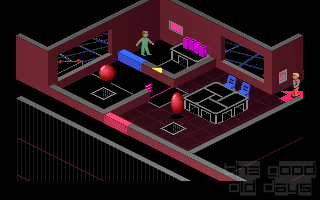The Atari 2600 had a comically long commercial life. Finally discontinued the same day as its successor's successor, the opportunity to be sold to countries of the former Eastern Block at low prices and its remaining installed userbase still made it a viable target of commercial game development up until the early 1990s. Most of these late games were ports of Atari's or other companys' Arcade hits. Or imitations of those. Showcasing more than anything else how old this hardware had really become by this point. In 1989, Atari released Double Dunk – an original 2600 development, not available on any other system.
And, honestly, it is a nice one. It does what the 2600 does best: a single static screen, four sprites, simple mechanic and quick gameplay.

Simulating a 2-on-2 basketball game with only one basket, the rules have been implemented well (as far as I can remember them…). The offensive duo tries to score, but as long as the ball has not hit wood, the defending team can simply steal and score for itself. A rebound after a miss necessitates to move out of bounds again and regroup.
Simple enough. The special thing about it is that unlike pretty much any sports game out there at the time, Double Dunk does not fully rely of twitchy reactions. Before each offense possession, the player gets to choose a play mode, sort of secretly. Unless the other player looks at the joystick, that is. This play then determines the strategy of movement and shots. How many passes to be made? Who shall shoot, if all goes right? Should the artificial intelligence controlled player move left or right in anticipation of a pass? If, of course, an open opportunity presents itself, the player can choose to shoot regardless.
It brings some structure into the otherwise highly hectic action. Player abilities being symmetric between the teams and little room to maneuver available, passing an opponent while dribbling is essentially impossible. At least playing against the artificial intelligence with its perfect reaction times.

In single player, it is essentially an attempt to not lose too badly and gradually improving one's skills. Which works with some patience, even if the first matches are hopeless. The AI is great at stealing the ball, being off with it and scoring before regular players may even have a chance to react. Overlapping sprites do make it hard to figure out who is even in possession often enough.
Against another human player, things play a bit differently. Both fighting with the same constraints, there is of course a good amount of luck to be had to win. Though knowing the plays and applying them in a targetted, efficient manner will also lead to a significant number of points. Which, finally, is what makes a good game, doesn't it? The ability to learn and master it within reasonable means.
Would this have impressed any owners of a contemporary home computer or newer generation game console in 1989? Of course not. Claiming anything along those lines would be delusional. Yet, if the 2600 was all you had, this could have been a nice pick. The chances of finding a like-minded competitive player would have been slim even then. Maybe worse than today, even. Because as soon as you had put this on in front of a friend having access to more modern hardware, a sound mocking would have been inevitable – even if not deserved.

Comments (1) [Post comment]